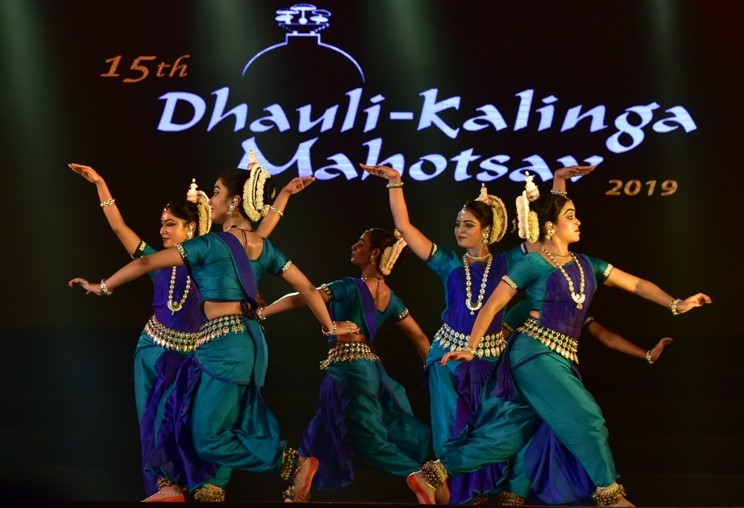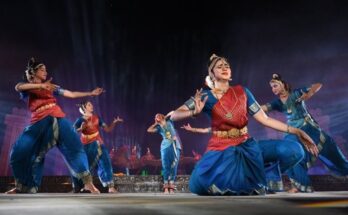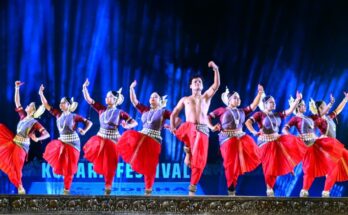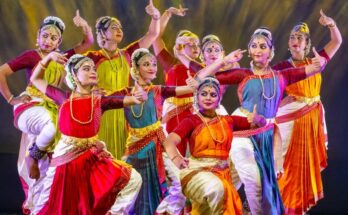By Leela Venkataraman
Having attended the Dhauli Kalinga festival for a few years now, for me it is the feel good factor that I carry with me this year as its greatest takeaway. The hysteria of fault-finding among warring groups, which has become so shrill of late in our country, has led to a dispirited feeling of tremendous letdown in every person. And an event, which for a change plays the tune of togetherness, of peace, and of progress is like a breath of fresh air.
India’s legacy of historic sites and archival remains from a very long past, is perhaps second to none. Using these spaces as a backdrop for artistic events is not new. I recollect watching Balasaraswati in the 1960s performing at the Red Fort, which was the venue for a mega dance festival organised by the central cultural affairs ministry. One recollects how National School of Drama’s ‘Tughlak’ staged in the Purana Quila, evoked powerful vibes of history. Madhya Pradesh’s Khajuraho Festival, Tamilnadu’s Mahabalipuram Festival, Odisha’s Konark Festival, Mukteshwar Festival, Rajarani Festival to name a few, are permanent events on the country’s cultural calendar.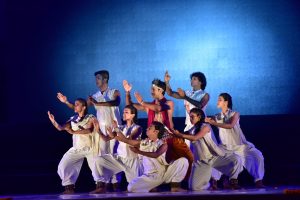
While such festivals at historical sites may be dime a dozen, each annual event to save it from being the usual song and dance routine, needs careful nurturing over a period of time to acquire a specific identity. And in this sphere, few states would seem to compare with Odisha, where culture has, under the tourism ministry been given a special thrust. While projecting our art forms for tourist attraction may not be an unmixed blessing, at times tempting the ushering in of populist trends taking away from excellence, the state, by having constant watchdog committees for selection of artists for festivals would seem to have, to a large extent, mitigated this possibility. And one must admit that few state governments spend so generously on mounting constant festivals of music and dance.
The Dauli-Kalinga festival, an inspiration of late Guru Gangadhar Pradhan, with Ileana Chitarishti under Art Vision working out a modest festival of Martial Art forms presented in the verandah of the Peace Pagoda at Dhauli, has today grown into a three-day spectacle mounted at the foothills, covering classical/ tribal/ folk dances and martial art skills, and much more this year in the shape of “Make in Odisha”.
Right from a silent oath of peace with burning torches in the hands of the chief guests, raised as a salutation to the Peace Pagoda, right through the proceedings the theme of peace is reaffirmed through a coming together of various art forms. The martial arts representing the skills (of protection if attacked) underline that there can be no peace without strong means of safeguarding oneself from assault and aggression, and can there be a more compelling site for propagating the message of peace than on the grounds, which ran crimson with the blood of mutilated soldiers in the Kalinga War – the ravaged sight of which overnight transformed ‘Chanda Ashok’ to ‘Dharma Ashok’?
The driveway, the arched gateway with flowers leading to an open area with its magnum sized photographs, the whole area enclosed with carved panels imitating temple patterns leading one to the expanse of the large performance area, open to the skies, specially erected, with a view of the magnificently lit Peace Pagoda, and the adjacent Shiva temple, are all indicators of how meticulously the state maps out the entire festival area.
Different classical dance traditions along with contemporary dance, coming together in the opening production Gitamahatmyam was significant, for the message of the Gita goes beyond regional considerations. Odissi by Aruna Mohanty and group, Bharatanatyam by Anitha Guha’s group, Kathak with Gauri Diwakar and group and contemporary dance by Janardhan Raj Urs and his disciples from Bengaluru – under the overall direction of Aruna Mohanty with foundational research by Kedar Mishra, Mohanty and Sanskritologist Nityananda Misra in selection of verses from the Gita, succeeded in catching the main burden of Krishna’s message to Arjuna in a one and a half hour performance. And how smoothly it was done thanks to Mohanty’s overall designing visualised by the very professionally trained dancers! The way each dance form shared stage space with other forms, retaining its individuality while still forming part of one large cameo was wonderful to watch. And in the main roles as Krishna and Arjuna, Biswajeet Das (Odissi) and Pavitra Bhatt (Bharatanatyam) made an excellent twosome. Almost stupefying the viewer with a non-stop barrage of vivid images and formations the production narratives underlined several aspects of the Gita teachings like the mortality of the body which has to decay and perish, of the immortality of the soul or atma which no cosmic element like water or fire can hurt, the need to eradicate desire which by consuming the mind kills intelligence thereby prompting actions which lead to unhappiness (as Sita’s desire for the golden deer, prompting Rama to go after it and finally her abduction by Ravana).
That every micro unit of this Cosmos, is part of that Macro entirety, which is Krishna was made clear through the Vishwaroopa vision. Expanding on the limitless nature of Jnana or Knowledge, Krishna’s declaration also certified that every time the burden of evil threatens this universe, he will appear donning some form to crush it and reinforce the supremacy of good. And at the end, without telling Arjuna what exactly he should do, Krishna merely says that now that he has shown him everything, it is for Arjuna to choose his path. And on the query of what the next step should be if his action did not lead to success, Krishna’s answer is that one’s duty should be done, without coveting the fruits. While many of the Gita verses are well known, the trick lies essentially in bringing the different strands together in one non-jerky narrative and that is achieved with aplomb. Substantiating as a complementary factor the stage images were the strong visuals screened on the rear screen. The main fabric of music composed by Ramahari, had Carnatic and Hindustani interventions at points suiting the Bharatanatyam and Kathak sectors. In this area too, preserving the musical flow undisturbed was important. And making the work more relevant to the present was relating the Gita message to contemporary times with the narrative on Gandhi and his fight for Independence, which he chose as his dharma, the movement visualisation of this segment largely the work of the contemporary dancers. For one constantly watching dance, it was heartening to see how the eternal hierarchical divide between the Classical and the Modern was blurred by making both genres share stage space.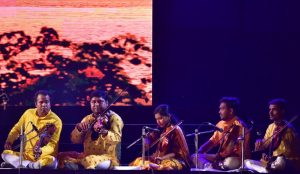
There were other classical dance groups. Nrityantara Academy of Performing Arts, Bengaluru run by Madhulita Mohapatra presented an item on Shiva as Neelakantha, as Jatadhara/ Gangadhara, as Mrtyunjay and as Nataraja the King of Dancers. The dancers clad in a pleasing pink costume, revealed good synchronisation. In the second item based on Purandhara Dasa’s “Hari smarana Mado” the attempt to make the words sung in a typical Odissi tune, one feels, was tricky. Language in its metre and the music it is set to, have a relationship, which in this case seemed at odds for this critic. While Vijayakumar Jena’s diction was fine, the singing style (despite Vijayakumar Barik’s mardala accompaniment) made the sahitya sound alien.
Far away from the exhibitionistic Kathak one is generally treated to, Rani Khanam’s Kathak with the Lucknow ‘andaz’ revels in underplayed artistry- seen in both the Surdas composition “Nachata Sudhanda Sreenandananda” followed by Yamunashtakam. It was Kathak without any attempt at showing off one’s skill. And Khanam quietly weaves in all the aspects of technique in Nritta like Thata, Tukra, Chal, Kavit, Gat, Paran, etc with Chakkars and tatkar in the group narrative. Tracing the flow of the Yamuna from its source to its mouth when it merges with the Sea, in many moods, can be a metaphor of life itself with its unpredictable highs and lows. And, very sensitive point was the feel of a river flowing, reflected in the tenor of the rhythm. But, even given all these strong points, Khanam would be well advised to bring in some of the razzmatazz of nritta so as to provide high points for an audience seated too far away in the open, while she and her group are performing on a very large stage open to the skies – where subtleties get lost without getting fully communicated to the audience. The recorded music was good and one particularly appreciated the mellow melody of the tabla, which stood out without overawing the rest of the music.
This festival curation in more ways than one revealed an inclusivity, which allowed for art traditions having to accommodate contemporary sensibilities. And this was particularly represented in what has come to be called the Neo-Classical in Odissi an example of which was Ratikant Mohapatra’s choice and choreography of ‘Keerwani Madhurima’ presented by Srjan. Basing the dance visualisation on music composed by Vyzarasu S.Balasubramaniam itself is a departure from the usual, for the composition, while based on the classical Keerwani raga, has a light popular tone to it. In its meticulous synchronisation of dance with movements typically Odissi, the work displayed high quality. Costumed in pleasing colours, the fine formations and immaculate performance of the dancers made this an excellent bridge between light entertainment and rigid classicism. And for the many occasions when corporate functions and other events would like to present fare which does not offend classicism ut also reaches out to a cosmopolitan uninitiated audience, a production like Keerwani Madhurima is just right. To be able to push the limits of an art form, without distorting the identity and central concerns of the tradition will ultimately depend on the boundaries each choreographer sets for himself.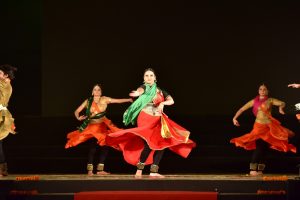
The next number Ardhanariswar based on highlighting the complementing and contrasting iconographic traits of male and female principles of Shiva and Parvati enshrined in one entity, was composed on music set by late Raghunath Panigrahi. It began with dancers one behind the other, the body in the rear partially visible (a dramatic device very suitable for showing the half -male half- female identity of Ardhanariswar first seen in a work on the same theme, presented by Anitha Guha in Bharatanatyam) the narrative thereafter changing to two groups. So what began as one entity housing both male and female principles in complement became two groups portraying special features of Parvati and Shiva.
The Martial Art forms segment treated one to Mayurbhaj Chau by Mayur Art Centre, Bhubaneswar who staged Paika Bidrohi, Manipuri Thang Ta, by Rajen Mangang Cuktural Association, Imphal with all the wizardry with sword and shield fights, and sticks, and fire eaters, and last but not least was the Sreejith T.R. group from Kerala who presented Modern Dance, the movements of which were a derivative from the regional martial art form of Kalaripayattu.
As for the concluding spectacle of “Make in Odisha”, an extraordinary blend of the ancient and the new, of art and science, of the legacy of Odisha and where it is headed, of years of history and the vision for the future, of the old city with its countless archaeological remains adjacent to the new city with its tree lined boulevards and its modern artefacts, its mining industries, its steel plants, its forests and rivers, its delicate filigree work, its handloom fabrics, its art forms tribal/ folk and classical and its people, it stupefied with its sheer abundance. And cooperating in this extravaganza again visualised by Aruna Mohanty, were Orissa Dance Academy from Bhubaneswar, Cornucopia Creations from Bengaluru, Md. Saiful Haque with his students from Moksha Cuttack. What with telescopic booms, very slick and aesthetic looking, transporting performers through the air from one part of the stage to the other, with women in designed costumes and women chef s in typical caps tripping the light fantastic, dancers gracefully parading crossing the stage holding a large bed sheet over their heads with mineral samples in varying shapes, the entire treatment buzzed with imaginative ideas. What with the fast changing vivid formations and colours on the stage along with the extraordinary visuals flashed on the back screen, this mind numbing fantasy of vitality while focused on Odisha, had collaborators from other parts in so many disciplines that it was not just the proud Odisha viewer but the proud Indian whose heart was swelling. In a festival where from the culture of the Ganga and Yamuna, to that of Mahanadi and Daya, to the shores of the Cauvery and Tanjore, to the rivers and waters of Kerala, ‘Make in Odisha’ evoked the feel good factor in every Indian. The festival became not just a sponsor of art from all parts of India but a celebration of arts from all over. And that in today’s India where gloom is spread all too easily, one values!

